Chicago Housing Authority
The Chicago Housing Authority (CHA) is a municipal corporation that oversees public housing within the city of Chicago. The agency's Board of Commissioners is appointed by the city's mayor, and has a budget independent from that of the city of Chicago. CHA is the largest rental landlord in Chicago, with more than 50,000 households. CHA owns over 21,000 apartments (9,200 units reserved for seniors and over 11,400 units in family and other housing types). It also oversees the administration of 37,000 Section 8 vouchers. The current acting CEO of the Chicago Housing Authority is Tracey Scott.
.png) | |
| Agency overview | |
|---|---|
| Formed | 1937 |
| Jurisdiction | City of Chicago |
| Headquarters | 60 E. Van Buren Street Chicago, Illinois, U.S. |
| Annual budget | $976 million (2015)[1][2] |
| Agency executive |
|
| Website | thecha |
History
The CHA was created in 1937 to own and operate housing built by the federal government's Public Works Administration. In addition to providing affordable housing for low-income families and combating blight, it also provided housing for industry workers during World War II and returning veterans after the war. By 1960, it was the largest landlord in Chicago. In 1965, a group of residents sued the CHA for racial discrimination. After the landmark court decision Gautreaux v. Chicago Housing Authority (see below), the CHA was placed in receivership, which would last for more than 20 years. Things continued to deteriorate for the agency and its residents, and by the 1980s, the high concentrations of poverty and neglected infrastructure were severe. The Chicago Housing Authority Police Department was created in 1989 to provide dedicated policing for what had become one of the most impoverished and crime-ridden housing developments in the country, and was dissolved only ten years later in 1999. The situation became so dire that Housing and Urban Development took control of the agency from 1987-2010.[3][4]
Plan for Transformation/Plan Forward
In 2000, the CHA began its Plan For Transformation, which called for the demolition of all of its gallery high-rise buildings and proposed a renovated housing portfolio totaling 25,000 units. In April 2013, CHA created Plan Forward, the next phase of redeveloping public housing in Chicago. The plan includes the rehabilitation of other scattered-site, senior, and lower-density properties; construction of mixed-income housing; increasing economic sales around CHA developments; and providing educational and job training to residents with Section 8 vouchers.[3][5] The Plan for Transformation has aiilso been plagued with problems. In 2015, the Secretary of Housing and Urban Development criticized the Chicago Housing Authority for accumulating a cash reserve of $440 million at a time when more than a quarter million people are on the agency's waiting list for affordable housing[6] and for holding an annual lottery for candidates to seek a spot on the wait-list.[7] The CHA also faced criticism for leaving a large number of units vacant (16%) and for slowing its pace of adding units.[7][8][9]
Demographics
From its beginning until the late-1950s, most families that lived in Chicago housing projects were Italian immigrants. By the mid-1970s, 65% of the agency's housing projects were made up of African Americans. In 1975, a study showed that traditional mother and father families in CHA housing projects were almost non-existent and 93% of the households were headed by single females. In 2010, the head of households demographics were 88% African American and 12% White.[10] The population of children in CHA decreased from 50% in 2000 to 35% by 2010. Today on average, a Chicago public housing development is made up of: 69% African-American, 27% Latino, and 4% White and Other.[11]
List of Chief Executive Officers
| Name | Term | Appointed by | Cite |
|---|---|---|---|
| Elizabeth Wood | 1937 – August 23, 1954 | Edward Kelly | |
| William B. Kean | October 1, 1954[12] – August 14, 1957 | Edward Kelly | |
| Alvin E. Rose[13] | September 1, 1957 – November 26, 1967[14] | Richard J. Daley | |
| Clement Humphrey[15] | December 2, 1967 – 1973 | Richard J. Daley | |
| Harry J. Schneider[16] | July 1, 1973 – 1975 | Richard J. Daley | |
| G. W. Master | August, 1975 – April, 1976 (acting)[17] May, 1976 – October 1, 1979 | Richard J. Daley | |
| Charles R. Swibel[18] | October 15, 1979 – June 1981 | Jane Byrne | |
| Andrew Mooney | June 1981[19] – July 26, 1982 (acting) August 1, 1982 – May 1, 1983 | Jane Byrne | |
| Zirl N. Smith | May 30, 1983 – January 7, 1987[20] | Harold Washington | |
| Brenda J. Gaines | January 19, 1987– May 6, 1988 (acting) | ||
| Vincent Lane[21] | May 6, 1988[22] – May 30, 1995 | Eugene Sawyer | |
| Joseph Shuldiner[23] | May 30, 1995[24] – September, 1995 (acting) October 16, 1995[25] – June 1, 1999 | HUD | |
| Terry Peterson | June 1, 1999 – August 30, 2006[26] | Richard M. Daley | |
| Sharon Gist-Gilliam | August 31, 2006 – January 16, 2008 (acting) | Richard M. Daley | |
| Lewis Jordan[27] | January 16, 2008 – June 30, 2011[28] | Richard M. Daley | |
| Charles Woodyard | October 24, 2011 – October 15, 2013[29][30] | Rahm Emanuel | |
| Michael Merchant | October 16, 2013 – June 5, 2015 | Rahm Emanuel | |
| Eugene Jones | June 8, 2015 – September 10, 2019 (acting CEO June 8, 2015 — February 6, 2016) | Rahm Emanuel | [31][32][33][34] |
| James L. Bebley | 17 September 2019 — 30 March 2020 (acting) | N/A | [34][35] |
| Tracey Scott | 30 March 2020 — Present | Lori Lightfoot | [36][34][37] |
Lawsuits
Gautreaux v. Chicago Housing Authority
In 1966, Dorothy Gautreaux and other CHA residents brought a suit against the CHA, in Gautreaux v. Chicago Housing Authority. The suit charged racial discrimination by the housing authority for concentrating 10,000 public housing units in isolated black neighborhoods, stating that the housing authority and Housing of Urban Development (HUD) had violated the U.S. Constitution and the 1964 Civil Rights Act. It was a long-running case that in 1996 resulted in the US Department of Housing and Urban Development (HUD) taking over the CHA and the Gautreaux Project in which public housing families were relocated to the suburbs. The lawsuit was noted as the nation's first major public housing desegregation lawsuit.[38]
Other lawsuits
In May 2013, The Cabrini-Green Local Advisory Council and former residents of the Cabrini-Green housing project sued the housing authority for reneging on promises for the residents to return the neighborhood after redevelopment. The suit claimed that the housing authority at the time had only renovated a quarter of the remaining row-houses, making only a small percentage of them public housing.[39]
In September 2015, four residents sued the housing authority over utility allowances. Residents claimed the CHA overcharged them for rent and didn't credit them for utility costs.[40]
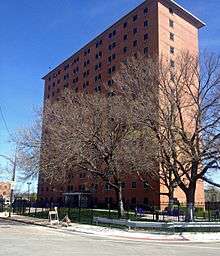
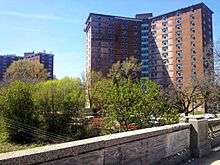
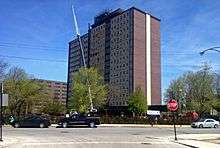
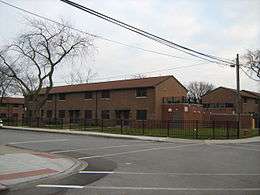
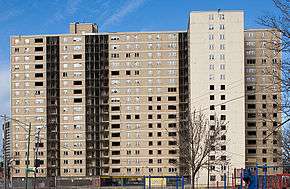
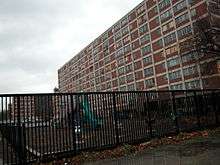


Developments
Housing projects
| Name | Location | Constructed | Notes/status |
|---|---|---|---|
| Altgeld Gardens Homes | Chicago/Riverdale, Illinois borderline (Far–south side) | 1944–46; 1954 | Named for Illinois politician John Peter Altgeld and Labor movement leader Philip Murray. 1,971 units of 2-story row-houses; Renovated. |
| Bridgeport Homes | Bridgeport neighborhood (South–west side) | 1943–44 | Named after its neighborhood location, Consist of 115 units of 2-story row-houses, Renovated. |
| Cabrini–Green Homes | Near–North neighborhood | 1942–45; 1957–62 | Named for Italian nun Frances Cabrini and William Green. Consisted of 3,607 units, William Homes and Cabrini Extensions (Demolished; 1995–2011), Francis Cabrini Row-houses (150 of 586 Renovated; 2009–11). |
| Clarence Darrow Homes | Bronzeville neighborhood (South side) | 1961–62 | Named for American lawyer Clarence Darrow, Consisted of 4 18-story buildings, Demolished in late–1998. Replaced with Mixed-income housing development Oakwood Shores.[41] |
| Dearborn Homes | Bronzeville neighborhood (South side) | 1949–50 | Named for its street location Dearborn Street; Consist of 12 buildings made up of mid-rise, 6 and 9-stories, totaling 668 units, Renovated. |
| Grace Abbott Homes | University Village (Near–west side) | 1952–55 | Named for social worker Grace Abbott, Consisted of 7 15-story buildings and 33 2-story rowhouses, totaling 1,198 units. Demolished. |
| Harold Ickes Homes | Bronzeville (South side) | 1953–55 | Named for Illinois politician Harold LeClair Ickes, 11 9-story high-rise buildings, totaling 738 units, Demolished. |
| Harrison Courts | East Garfield Park neighborhood (West side) | 1958 | Named after its street location; Consist of 4 7-story buildings; Renovated. |
| Ogden Courts | North Lawndale neighborhood (West side) | 1953 | Named after William B. Ogden location; Consist of 2 7-story buildings; Demolished. |
| Henry Horner Homes | Near–West Side neighborhood | 1955–57; 1959–61 | Named for Illinois governor Henry Horner, Consisted of 16 high-rise buildings, 2 15-story buildings, 8 7-story buildings, 4 14-story and 2 8-story buildings, totaling 1,655 units ; Demolished. Replaced with Mixed-income housing development West Haven. |
| Ida B. Wells Homes | Bronzeville neighborhood (South side) | 1939–41 | Named for African-American journalist Ida Barnett Wells, Consisted of 1,662 units (800 row-houses and 862 mid-rise apartments); Demolished. Replaced with a Mixed-income housing development named Oakwood Shores.[41] |
| Jane Addams Homes | University Village (Near–west side) | 1938–39 | Named for social worker Jane Addams, Consisted of 32 buildings of 2, 3, and 4 stories, totaling 987 units; Demolished. Replaced with townhouses and condominiums under the name Roosevelt Square. |
| Julia C. Lathrop Homes | North Center neighborhood (North side) | 1937–38 | Named for social reformer Julia Clifford Lathrop, Consist of 925 units made up of 2-story row-houses, mid-rise buildings; Renovated. |
| Lake Parc Place/Lake Michigan Homes High-Rises[42] | Oakland neighborhood (South side) | 1962–63 | Named after its location, Consisted of 6 buildings; Lake Michigan high-rises (also known as Lakefront Homes) (4 16-story buildings; vacated in 1985 and demolished by implosion on 12/12/1998[43][44]) and Lake Parc Place (2 15-story buildings; renovated) |
| Lawndale Gardens | Little Village neighborhood (South–west side) | April–December 1942 | Named for its street location, Consist of 123 units of 2-story row-houses, Renovated. |
| LeClaire Courts | Archer Heights neighborhood (South–west side) | 1949–50; 1953–54[45] | Consisted 314 units of 2-story row-houses;[46] Demolished. |
| Loomis Courts | University Village neighborhood (Near–west side) | 1951 | Named for its street location, Consist of 2 7-story building, totaling 126 units. |
| Lowden Homes | Princeton Park neighborhood (South side) | 1951–52 | Named for Illinois governor Frank Lowden, Consist of 127 units of 2-story row-houses; Renovated. |
| Madden Park Homes | Bronzeville neighborhood (South side) | 1968–69; 1970 | Consisted of 6 buildings (9 and 3-stories), totaling 279 units; Demolished. Replaced with a Mixed-income housing development named Oakwood Shores.[41] |
| Prairie Courts | South Commons neighborhood (South side) | 1950–52 | Consisted of 5 7 and 14-story buildings, 230 units made up of row-houses, totaling 877 units; Demolished. Replaced with new development which was constructed between 2000–2002. |
| Racine Courts | Washington Heights neighborhood (Far–south side) | 1953 | Named for its street location, Consisted of 122 units made up of 2-story row-houses,[47] Demolished. |
| Raymond Hilliard Homes | Near–South Side neighborhood | 1964–66 | Consists of 3 buildings, 22-story building; 16-story building and 11-story building, totaling 1,077 units. Renovated in phases, Phase I: 2003–04; Phase II: 2006–07. |
| Robert Brooks Homes/Extensions | University Village neighborhood (Near–west side) | 1942–43; 1960–61 | Consist of 835 row-houses (Reconstructed in phases: Phase I: 1997–99, Phase II: 2000), 3 16-story buildings (450 units; Demolished between 1998–2001) . |
| Robert Taylor Homes | Bronzeville neighborhood (South side) | 1960–62 | Named for named the first African American chairman of the Chicago Housing Authority Robert Rochon Taylor, Consisted of 28 16–story high rises, totaling 4, 415 units; Demolished between 1998–2007. Replaced with a Mixed-income housing development named Legends South.[48] |
| Rockwell Gardens | East Garfield Park neighborhood (West side) | 1958–60 | Named for its street location; Consisted of 1,126 units made up of 11 buildings (16, 14-stories); Demolished between 2003–2007. Replaced with a Mixed-income housing development named West End. |
| Stateway Gardens | Bronzeville neighborhood (South side) | 1955–58 | Named for its location along State Street, Consisted of 8 buildings (13-17 stories); Demolished between 1996–2007, Replaced with a Mixed-income housing development named Park Boulevard. |
| Trumbull Park Homes | South Deering neighborhood (Far–south side) | 1938–39 | Consist of 434 units made up of 2-story row-houses and 3-story buildings; Renovated. |
| Wentworth Gardens | Armour Square[49] neighborhood (South side) | 1944–45 | Named for its street location and the major league baseball team that used to play in its baseball field. Stretching from 39th & Wentworth to 37th and Wells this housing Project is one of Cha'S Finest., Consist of 4 block area of 2-story row-houses, 3 mid-rise buildings; Renovated. |
| Washington Park Homes | Bronzeville neighborhood (South side) | 1962–64 | Named for nearby Chicago Park District park and neighborhood, Consisted of 5 17-story buildings located between 45th and 44th Streets, Cottage Grove Avenue and Evans Street; Demolished between 1999 and mid-2002. |
Notable residents
- R. Kelly–Ida B. Wells Homes
- Mr. T– Robert Taylor Homes
- Maurice Cheeks–Robert Taylor Homes
- Curtis Mayfield–Cabrini-Green Homes
- Eric Monte–Cabrini-Green Homes
- Jerry Butler–Cabrini-Green Homes
- Kirby Puckett–Robert Taylor Homes
- Deval Patrick–Robert Taylor Homes
- Marvin Smith–Robert Taylor Homes
- Lou Rawls–Ida B. Wells Homes
See also
- Hills v. Gautreaux, a 1976 Supreme Court case
- Chicago Housing Authority Police Department
- Marshall Field Garden Apartments
References
- "CHA - FINANCIAL REPORTS". Archived from the original on 2016-06-30. Retrieved 2016-06-16.
- Chicago Housing Authority passes 2012 budget
- "About | The Chicago Housing Authority". www.thecha.org. Retrieved 2020-07-03.
- "Judge ends CHA receivership". Crain's Chicago Business. 2010-05-20. Retrieved 2020-07-04.
- CHA reveals next phase of massive public housing redevelopment
- HUD Secretary Troubled By CHA Hoarding Millions « CBS Chicago
- Rahm Emanuel’s Next Scandal? Chicago’s Public Housing | New Republic
- For Some Chicago Residents, Mixed Emotions on Affordable Housing | Chicago Tonight | WTTW
- Chicago Housing Authority maintains thousands of vacant apartments - tribunedigital-chicagotribune
- Demographics Of Public Housing Families Evolve
- 2010 Census
- Retired Army officer new CHA rent chief (Chicago Tribune - December 16, 1954)
- CHA to open bids on new housing units (Chicago Tribune - December 12, 1964)
- Gautreaux v. Chicago Housing Authority, 296 F. Supp. 907 (N.D. Ill. 1969)
- Ex-cha Chief Clement Humphrey dies at 82 (Chicago Tribune - October 28, 1990)
- Harry J. Schneider, Former Director Of CHA dies (Chicago Tribune - November 11, 1987)
- Chicago gets plus on public housing (Chicago Tribune - February 19, 1976)
- Charles Swibel: Ex CHA chief dies (Chicago Tribune - January 20, 1990)
- CHA exec. in line to succeed Swibel (Chicago Tribune - July 9, 1982)
- Robinson Quits As CHA Chief (Chicago Tribune - January 17, 1987)
- The Historymakers - Vincent Lane (1942-)
- High Noon at the housing project: Chicagoan Vincent Lane organizes "sweeps" to drive out drug dealers (Ebony Magazine - August 1989)
- Joseph Shuldiner - Executive Director, Chicago Housing Authority (Chicago Tribune - July 5, 1998)
- Hud Exec. To Be CHA Director (Chicago Tribune -September 22, 1995)
- Name: Joseph Shuldiner Job: Executive director of the... (Chicago Tribune - October 01, 1995)
- TERRY PETERSON STEPS DOWN AS CHICAGO HOUSING AUTHORITY EXECUTIVE DIRECTOR (August 30, 2006)
- Ex-CHA resident takes over agency - Jordan to finish transformation plan, Daley says (Chicago Tribune - December 12, 2007)
- Embattled CHA CEO Lewis Jordan resigns (Chicago Tribune - June 14, 2011)
- Former CHA CEO Woodyard resigned amid sexual harassment allegations (WBEZ - November 18, 2013)
- Chicago Tonight - CHA CEO Woodyard resigns - October 15, 2013
- Spielman, Fran (20 August 2019). "CHA CEO abruptly resigns, ending highly acclaimed, four-and-a-half-year reign". Chicago Sun-Times. Retrieved 17 March 2020.
- "MINUTES OF THE REGULAR MEETING OF THE COMMISSIONERS OF THE CHICAGO HOUSING AUTHORITY February 16, 2016" (PDF). Chicago Housing Authority. 16 February 2016. Retrieved 17 March 2020.
- "Mayor Emanuel Nominates Eugene Jones, Jr. as CEO of the Chicago Housing Authority | The Chicago Housing Authority". www.thecha.org. Chicago Housing Authority. 29 January 2016. Retrieved 17 March 2020.
- "RESOLUTION NO. 2019-CHA-" (PDF). Chicago Housing Authority. 17 September 2019. Retrieved 17 March 2020.
- "Executive Team | The Chicago Housing Authority". www.thecha.org. Chicago Housing Authority. Retrieved 17 March 2020.
- Quig, A.D. (6 March 2020). "Lightfoot names her pick to head Chicago Housing Authority". Crain's Chicago Business. Archived from the original on March 16, 2020. Retrieved 16 March 2020.
- https://www.thecha.org/about/executive-team
- BPI Chicago - The Gautreaux Lawsuit - 1966
- Chicago Business - Tenant Gruoup Sues Chicago Housing Authority - May 16, 2013
- Chicago Tribune - CHA Utility Lawsuit - September 25, 2015
- "Chicago Housing Authority - Oakwood Shores". Archived from the original on 2009-07-01. Retrieved 2013-04-08.
- Washington Park: The Dying Hope
- Yo Chicago: Polishing Bronzeville
- Fall Of High-rises Lifts Hopes Of Area - The Planned Implosion Of Four 16-story Cha Buildings Is Seen By Some As The Symbolic Funeral Of An Outdated Policy - Chicago Tribune (December 11, 1998)
- Desktop Documentaries: Leclaire Courts(Chicago, Illinois)
- Chicago Tribune: LeClaire Courts residents await word whether development will be shut down (September 12, 2008)
- Chicago Tribune: CHA Renters May Get Option To Buy (January 28, 1985)
- "Hope VI funds new urban neighborhoods". New Urban News. Jan–Feb 2002. Retrieved 2013-04-08.
- Gardens
- Senior Properties: Chicago Housing Authority Archived September 21, 2013, at the Wayback Machine
- Scattered Sites Properties: Chicago Housing Authority Archived 2012-10-28 at the Wayback Machine
- Mixed-Income Properties: Chicago Housing Authority Archived August 17, 2013, at the Wayback Machine
- "Chicago Housing Authority". Encyclopedia of Chicago.
- "Gautreaux". Business and Professional People for the Public Interest. Archived from the original on 2007-09-13.
- "Latest Decision on Gautreaux v. Chicago Housing Authority". National Housing Law Project. Archived from the original on 2007-08-04.
Further reading
- Dizikes, Peter, "Chicago hope: Ambitious attempt to help the city’s poor by moving them out of troubled housing projects is having mixed results, MIT study finds", MIT News, MIT News Office, March 3, 2011.
- Blueprint for Disaster: The Unraveling of Chicago Public Housing, a 2009 book by D. Bradford Hunt.
- "Understanding Chicago's High-Rise Public Housing Disaster", in Chicago Architecture: Histories, Revisions, and Alternatives, edited by Charles Waldheim and Katerina Reudi Ray (University of Chicago Press, 2005).
- "How Did Public Housing Survive the 1950s?", Journal of Policy History, 17:2, Spring 2005, 193–216.
External links
- Chicago Housing Authority Official site